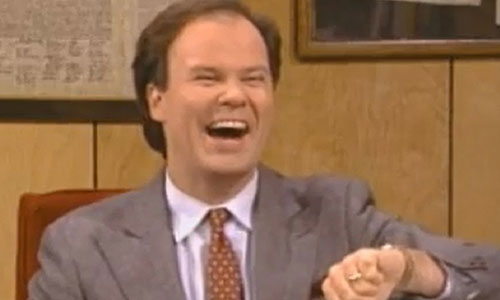Evolution, Televised
Weird television has a way of sucking you in, remaining appealing despite its oddity. Grown Folks Dancing is only the latest example of a longtime trend.
Today in Tedium: It may have been the greatest text message my wife had ever sent me. While I was in the middle of a deep sleep, she sent me a message informing me of the existence of a television show that raised the bar for quality late-night television on Saturday evenings. When I woke up and finally saw it, I knew that my life would never be the same, thanks to the fact that I know know that Grown Folks Dancing is a thing. It’s exactly what it sounds like, and it’s yet another example of why niche television rules. Today, we’re gonna tune in to some TV weirdness that you probably won’t find on Netflix. Cut the cord—all you need today is your WiFi. — Ernie @ Tedium
375+

So … anyway, about those Grown Folks Dancing …
As much as I’d like to credit my wife with being the first to spot the buzzworthiness of Grown Folks Dancing, I have to give the credit to Rembert Browne, the Grantland writer who picked up on the Hampton, Virginia-borne phenomenon back in December.
The Bob Thomas-hosted show, which features folks in their AARP-eligible years getting down in style, is simple in premise, low-budget in filming, and perfect in execution. It’s the epitome of the promise of great late-night television. The only thing that could make it better is if Elvira showed up wearing roller skates.
“They tape the show every third Sunday at a venue called the Comfort Zone in Hampton, Virginia,” Browne wrote. “Their most recently uploaded video was from the third Sunday in November. As in, this is happening in real time. Grown Folks Dancing is not the past. Grown Folks Dancing is right now.”
All TV shows should include uninterrupted segments of line dancing or, at the very least, be sponsored by Crystal Light.
Keeping the niche alive: modern examples of old-school TV formats
Then: For more than 30 years, bandleader Lawrence Welk kept audiences dancing like crazy with his namesake television show, offering a mix of polka and easy-listening standards, eventually evolving into a style known as “champagne music.” The approach involved a lot of music, a lot of dancing, and some old-school clothing. There’s been nothing really like it on TV since.
Now: While not truly the same thing, polka star Mollie Busta, a member of the popular polka band Squeezebox, has been holding court on RFD-TV with a somewhat similar show, Mollie B Polka Party, since 2011. Busta’s work actually became something of a centerpiece in the battle against Comcast’s merger with Time Warner Cable last year, after The New York Times used the show as an example of the kind of programming that could lose out big time due to a merger—a merger that RFD-TV founder Patrick Gottsch opposes.
Then: Soul Train managed to outlast Lawrence Welk’s namesake show, which is a feat in and of itself, staying on the air 35 years, continually updating the format as needed. Unlike Welk, mastermind Don Cornelius remained willing to constantly update the show as needed, even if it meant that he eventually needed to fire himself as host—something he did back in 1993. For much of its tenure, which ended in 2006, it was referred to as the “longest-running first-run, nationally syndicated program in American television history,” outlasting similarly long-lasting syndicated shows such as Welk’s and Hee Haw.
Now: We have Grown Folks Dancing, and life is wonderful.
Then: Artist Bob Ross spent 11 years hosting the popular PBS show The Joy of Painting, a show where he made painting look stupidly easy and made anyone feel like it was possible they could one day become the next Thomas Kinkade. All you need to make the perfect tree? A few brushstrokes.
Now: Artist John Kilduff has carried Ross’ torch into the modern age, albeit with a bizarro twist. His show, Let’s Paint TV, features Kilduff multitasking like a mofo—painting while on a treadmill, attempting to do secondary tasks in the process like surgery or making a smoothie. The show, which originated on Los Angeles-area public television, still exists today in YouTube format. If you’re a fan of Eric Andre’s Adult Swim show, you might dig this.
25

How the FCC ruined Saturday mornings
Ever wonder why they never show Saturday morning cartoons anymore? There are a combination of reasons for this shift away from high-quality animated programming, including cable programming, but perhaps the biggest reason for the change involves the Children’s Television Act, a law passed in 1990 and enforced by the Federal Communications Commission to mandate the existence of “educational and informative” programming, or E/I, on the broadcast airwaves. The move, the FCC explains, was in response to the growing amount of television that kids were watching.
“This invited ‘guest’ into our homes has the potential to significantly shape our children’s development,” the FCC explains on its website. “In view of this, Congress determined that broadcast television stations – both commercial and non-commercial—have an obligation to offer educational and informational children’s programming.”
The result of this change is that shows that would have appealed to young kids but perhaps weren’t strictly educational were replaced by shows with lower production values that nonetheless passed the rules.
The earliest such shows that fit the E/I standards were part of NBC’s teen lineup—formulaic sitcoms like Saved By the Bell: The New Class and California Dreams—and ultimately gave way to lower-quality fare that checked all the boxes but didn’t necessarily hold the entertainment appeal of Tiny Toon Adventures, Slowly, the networks turned a classic tradition into a commoditized no-man’s land. They got rid of much of their entertainment programming (i.e. the cartoons) in favor of a mix of reruns and Saturday newscasts that effectively showed the major networks throwing up their hands, conceding an entire morning to Nickelodeon and the Disney Channel.
These requirements have effectively led to a glut of certain kinds of programming, such as wildlife (Jack Hanna is well-represented in E/I timeslots) or science (Beakman’s World, which hasn’t seen new episodes since 1997), at the cost of higher levels of educational diversity.
“Across the entire commercial television landscape, we found only 3 percent of E/I episodes conveyed any lesson about art, only 3 percent addressed topics of nutrition or health, and only 1 percent devoted any attention to mathematics,” the group Children Now wrote in a 2008 study on the E/I phenomenon. “These findings clearly suggest that the range and diversity of E/I programming is limited, with a host of important topic areas overlooked.”
Meanwhile, cable TV networks aren’t held to the same standards and strict requirements, and the result is that the programming sucks a lot less.
In an era where it seems like every moment of ours is recorded, I’d like to finish this rant by pouring one out for a network that nobody remembers anymore, but deserves respect nonetheless. In 1946, the DuMont Television Network decided that it’d be a great idea to put up a fight against the NBCs of the world and launch its own television network. The network was a huge success at first, launching stars like Jackie Gleason and Ernie Kovacs into the mainstream, but ultimately fell flat due to a ruthless competition and its affiliates’ reliance on UHF, a technology that not all TVs supported in the ’50s.
It took 30 years for a new “fourth network” to show up, and time was not kind to DuMont’s imprint on history. In the ’70s, much of the network’s content, sitting in a warehouse somewhere, were destroyed—either by being dumped into the ocean or the kinescopes being destroyed for their silver content. We would lose our collective you-know-what if we found out such a travesty were to take place today—that a decade of our history were to be destroyed for the raw materials.
Want to know what it’d look like if the revolution wasn’t televised? It’d look like that.
Editor’s note: Due to an issue with the source, the last link in this piece has been changed from its original publishing date. The information remains accurate, however. (01/2017)
:format(jpeg)/2017/08/tedium021015--1-.gif)
/2017/08/tedium021015--1-.gif)

/uploads/ernie_crop.jpg)